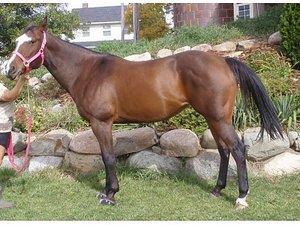Farewell to Harmony: Selling a horse is a basic, if sad, part of ownership

A woman of about 30 drove up in a pickup pulling an older model, rusty red stock trailer. She stepped out of the vehicle and lit up a cigarette. I introduced myself, and she introduced herself, switching the cigarette to the other hand to shake. A man emerged with a small, smiling girl of about 4, who was dressed in a pink coat.
“We’re here for Harmony.”
Harmony is a beautiful bay (dark brown with black legs, mane and tail) mare. She has a big, white T-shape on her forehead and one white foot. At first, Harmony’s big T strikes one as a bit kooky, but it becomes endearing. Harmony has an exceptionally sweet and kind personality, loves to be groomed and handled, and tries to please her rider. She doesn’t like to have her girth tightened quickly (similarly, we do not always like to have our belts tightened!) but prefers it be adjusted in increments.
An all-around mare, Harmony knows about English and Western riding and jumping. We bought her in 2007 for our lesson program from a 17-year-old girl, whose thoughts had turned from horses to boys. Before that, Harmony was owned by a woman who trained her to be ridden, and before that by the man who owned and bred Harmony’s parents.
Harmony has given countless lessons, patiently participated in our summer camps and has walked for hours with children at Pony Parties. Restructuring of our lesson program meant Harmony must be sold: she would have no one to regularly ride or give her special care, and it simply was no longer logistically or economically feasible to take good care of her. Harmony needed another home. And now that time had come.

Harmony stands in the summer sun.
Photo courtesy of Kathy Lundberg
Fate has blown some hard winds on Harmony. Born without enough white hairs to be registered as an American Paint Horse, she is considered “Breeding Stock Paint.” Undoubtedly, Harmony was a disappointment at the moment of her birth. Without flashy spots, she not desirable as a Paint, cannot be shown as Paint in many venues. Since her genetic background contains “color” her offspring may fare better if she is mated with Paint, and so she has potential value as a brood mare.
As a youngster, she became tangled in a barbed wire fence, resulting in a wound to her right back foot. Although it does not bother her or affect her movement, it is a blemish we humans do not like to see. Harmony was trained to be obedient to basic cues, but not well enough to win in a show ring, where primary colored ribbons (especially blue) are definitely best.
In 2008, Harmony experienced an injury to her front foot resulting in a condition known as “ring bone.” This is a permanent change to the foot, which often limits ability and may cause pain. Her jumping career was over, and she was restricted to walking and trotting under saddle, which kept her sound. The following year, Harmony was bred (artificial insemination) to a very nice Paint stallion, but for whatever reason, she did not conceive and was covetous of the foal her friend bore the following spring.
Harmony’s potential buyer is a horse trainer whose work entails buying, training and selling horses. Harmony was to be a personal horse for her husband and two young daughters to ride around on their property and to give some beginner lessons. They were looking for a healthy, quiet horse with a good disposition. Harmony fit the bill.
Paperwork was completed, money changed hands, and Harmony was sold. She was gently cajoled into the trailer. We closed the doors, and off they went, Harmony rustling around a bit in the creaky trailer. We cried to see her go, hugged each other, and went back to our work, wondering how Harmony would fare in her next home. Would they love her? Would they take good care of her? Will she be as happy as she was with us? Will we see her on Craigslist sometime soon?
Horses change hands throughout their lives for one reason or another. Harmony at age 12 has had five different owners. She may have “hit the jackpot” and found a home where she will be loved, cared for, given appropriate work for her abilities and retired at a ripe old age. Did Harmony trade up or down this time? How many others will claim her before she closes her eyes in death, likely at age 25-30? Time will tell, but who that has known this lovely mare will be there to hear the story? Goodbye Harmony, we truly wish you well.
Kathy Lundberg is the owner of Scio Church Stables. Email her at scs@sciochurchstables.com.


Comments
ypsicat
Thu, Jan 27, 2011 : 1:17 a.m.
I couldn't see a way to respond to Kathy's reply to my comment, so I'll just make a new post. Since feeling good about rehoming a horse or any other animal is such an integral part of the process it would have made the story feel more whole, and be educational as well, to list the things you did do to safeguard Harmony's well-being. As I'm sure you know, there are far too many horses ending up in a bad place and people need to be aware of this at every level.
julieswhimsies
Mon, Jan 31, 2011 : 10:05 p.m.
I know Kathy did everything in her power to safeguard Harmony. I considered selling my mare this Fall, and checked references (especially vet references, as they don't lie.) I met and heard from some pretty scary characters in my search for the perfect home for Sunny. It was scary. I ended up changing my mind, but Kathy was going through the same processes with Harmony. She is one of the most diligent, and loving horse person I have ever met. She took every precaution in making this difficult decision in choosing the right home for Harmony.
Marian Gregor
Wed, Jan 26, 2011 : 8:33 p.m.
I appreciated the 1st comment as there are so many unsuitable prospective horse owners. My friend was looking for a new forever home for her lovely Morgan. She discovered several scammers (both from ads on Dreamhorse & Craig's List). This has been especially prevalent with ads for free or inexpensive horses. The authorities informed my friend about a father/daughter team whose story about keeping the horse for a family mount was not on the "up & up". These poor horses went to slaughter. So the more checking the better! ps- her Morgan went to a local girl who trail rides him.
julieswhimsies
Wed, Jan 26, 2011 : 8:19 p.m.
Harmony was one of my horse's pasture buddies. Sunny and I will both miss Harmony.
Kathleen Lundberg
Thu, Jan 27, 2011 : 2:49 a.m.
Thanks, Julie. Many hours were spent talking on the phone, emailing, videoing, and screening prospective new homes, discussing the merits of each.
ypsicat
Wed, Jan 26, 2011 : 1:08 a.m.
There's a chunk missing in this story. It's the part, or parts, where you meet the prospective buyers, ask questions about their intentions (some of them pointed, necessarily), have the prospects meet Harmony to see if they get along and if so, you go to inspect the property they will be keeping Harmony to be sure it's up to standards, then you have them sign a buy back contract that if something goes wrong, you will take Harmony back. It might be that this was done, but I didn't see it in the article.
Kathleen Lundberg
Wed, Jan 26, 2011 : 2:27 p.m.
Great comment - thanks. There are lots of ways for prospective buyers and sellers to learn more about each other and the horse to determine suitability. Email communication is fast and easy. Videos can be made and sent via utube or email. You can search the person's name on the internet, you can check their website, get references. Visiting is a great option when feasible. Trail periods have risks and benefits to both sides, and are an option. "Right of first refusal" in the contract specifies that in the event the horse is re-sold, the current owner contacts the previous with the option to buy the animal back. Depending on circumstances, this may or may not be possible. Honesty about your horse's strengths and weaknesses is paramount in finding the right home. In this case, Harmony's limitations were not a problem for this knowledgeable family, and her strengths were exactly what they were looking for. In the end, when one has invested time, money and energy in a loved animal that one must part with for whatever reason, there is some trepidation. As the comment author points out, there are ways to increase your confidence in re-homing your horse, which should be be thoroughly explored.